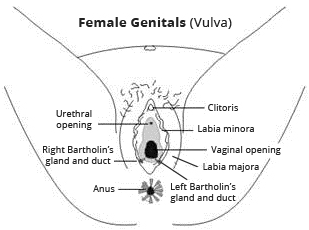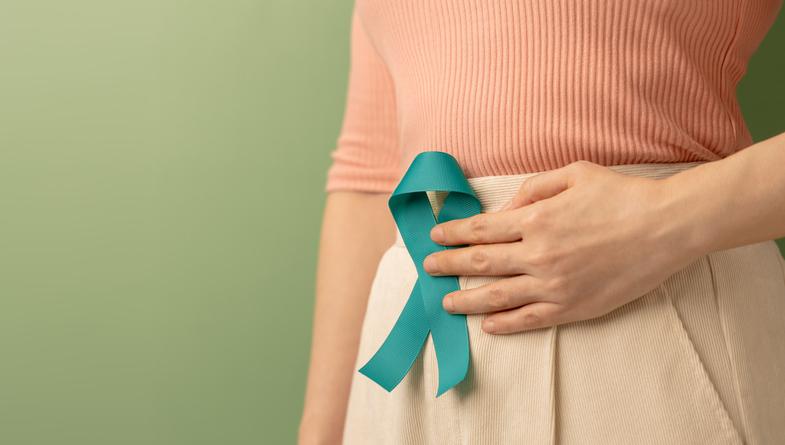Gynäkologischer Krebs
Begutachtet von Dr. Toni Hazell, MRCGPZuletzt aktualisiert von Dr. Philippa Vincent, MRCGPZuletzt aktualisiert am 26. Mai 2025
Erfüllt die Anforderungen des Patienten redaktionelle Richtlinien
- HerunterladenHerunterladen
- Teilen Sie
- Sprache
- Diskussion
In dieser Serie:Krebs der GebärmutterEierstockkrebsGebärmutterhalskrebsVulvakrebsIntraepitheliale Neoplasie der VulvaGebärmutterhalskrebs-Screening
In den weiblichen Fortpflanzungsorganen kann eine Reihe von Krebsarten auftreten. In dieser Broschüre wird erklärt, wo diese Organe liegen, und es gibt Links zu Informationen über die einzelnen Krebsarten.
In diesem Artikel:
Lesen Sie unten weiter
Die weibliche Anatomie
Gynäkologische Krebsarten sind Krebsarten, die in den weiblichen Fortpflanzungsorganen entstehen. Daher ist es hilfreich, sich ein Bild davon zu machen, was und wo diese entstehen.
Weibliche Fortpflanzungsorgane

Die Gebärmutter (Uterus) ist ein Hohlorgan mit Wänden aus Muskeln. In ihr wächst das Baby heran, wenn Sie schwanger sind. Die Innenauskleidung der Gebärmutter wird Endometrium genannt. Diese Schleimhaut wird jeden Monat abgestoßen und verursacht Blutungen, wenn Sie nicht schwanger sind.
Die untere Öffnung oder der Hals der Gebärmutter wird als Gebärmutterhals bezeichnet. Dies ist die Öffnung, durch die das Blut während der Periode aus der Gebärmutter fließt. Bei der Geburt dehnt er sich.
Der Gebärmutterhals befindet sich am oberen Ende einer muskulösen Röhre, der Vagina. Dies ist die Passage, durch die das Blut während der Periode fließt; sie dehnt sich auch während der Geburt aus. Beim Geschlechtsverkehr, wenn sich ein Penis in der Scheide befindet, werden Spermien aus dem Penis freigesetzt und können durch den Gebärmutterhals in die Gebärmutter gelangen. Wenn sich dort eine Eizelle befindet, kann dies zu einer Schwangerschaft führen.
Die Eierstöcke sind zwei ovale Organe, die auf beiden Seiten über die Eileiter mit dem oberen Teil der Gebärmutter verbunden sind. Die Eierstöcke produzieren Eizellen und geben sie in einem monatlichen Prozess, dem Eisprung, frei (wo sie durch die Eileiter in die Gebärmutter gelangen). Die Eierstöcke produzieren auch die weiblichen Hormone Östrogen und Progesteron.
Die Vulva ist der Teil des weiblichen Fortpflanzungssystems, der nach außen gerichtet ist. Sie ist der Teil des Genitalbereichs, der die Öffnung der Vagina umgibt.
Weibliche Genitalien

Die Vulva umfasst:
Die großen Schamlippen. Das sind eigentlich große Hautfalten.
Die kleinen Schamlippen. Dies sind zartere Hautfalten direkt innerhalb der großen Schamlippen.
Die Klitoris - ein kleines Organ, das an der sexuellen Erregung beteiligt ist.
Winzige Drüsen, von denen die Bartholin-Drüsen die bekanntesten sind.
Der Eingang zur Harnröhre - die Röhre, durch die der Urin aus der Blase geleitet wird.
Der Eingang zur Vagina.
Was ist Krebs?
Krebs ist eine Erkrankung, bei der sich Zellen eines bestimmten Körperorgans unkontrolliert vermehren. Diese abnormen Zellen können sich dann im ganzen Körper ausbreiten und Schäden verursachen. Krebserkrankungen in verschiedenen Organen sind unterschiedliche Krankheiten mit unterschiedlichen Symptomen und unterschiedlichen Behandlungen. Siehe das separate Merkblatt Krebs.
Wiedergabeliste: Gynäkologische Fragen und Antworten
5 Videos
Was ist Scheidenkrebs?
Prof. Lesley Regan, FRCOG
Was ist Scheidenkrebs?
Prof. Lesley Regan, FRCOG

Verursachen Krebserkrankungen der Gynäkologie Blutungen?
Dr. Sarah Jarvis MBE, FRCGP

Was sind die Symptome von Gynäkologiekrebs?
Dr. Sarah Jarvis MBE, FRCGP

Sind Krebserkrankungen der Gynäkologie schmerzhaft?
Dr. Sarah Jarvis MBE, FRCGP

Können gynäkologische Krebserkrankungen Unfruchtbarkeit verursachen?
Dr. Sarah Jarvis MBE, FRCGP
Lesen Sie unten weiter
Welche Arten von gynäkologischen Krebserkrankungen gibt es?
Krebs kann in jedem der weiblichen Fortpflanzungsorgane entstehen. Klicken Sie auf die unten stehenden Links, um mehr über die einzelnen Krebsarten zu erfahren.
Krebs in der Vulva. Eine Krebsvorstufe der Haut, die vulvale intraepitheliale Neoplasie (VIN), kann sich in einigen Fällen unbehandelt zu Vulvakrebs entwickeln.
Krebs der Vagina. Er ist sehr selten. Er tritt in der Regel bei älteren Frauen auf.
Krebs in den Eileitern. Dieser Krebs ist selten. Er hat meist ähnliche Symptome wie Eierstockkrebs und wird auf ähnliche Weise diagnostiziert und behandelt.
Gibt es Vorsorgeuntersuchungen für gynäkologische Krebserkrankungen?
Derzeit gibt es im Vereinigten Königreich ein nationales Screening-Programm für Gebärmutterhalskrebs, aber keines für die anderen gynäkologischen Krebsarten. Das liegt daran, dass Gebärmutterhalskrebs in vielen Fällen bereits in einem sehr frühen Stadium erkannt werden kann, bevor er überhaupt Krebs ist. Typische Zellveränderungen werden durch einen Abstrich festgestellt. Lesen Sie mehr über die Gebärmutterhalskrebs-Vorsorgeuntersuchung (den Gebärmutterhalsabstrich). Dieses Krebsvorstadium kann behandelt werden, damit sich kein Krebs entwickelt. Dies geschieht im Rahmen einer so genannten Kolposkopie. Lesen Sie mehr über die Kolposkopie und Behandlungen am Gebärmutterhals.
Es wurden Studien durchgeführt, um zu untersuchen, ob ein Eierstockkrebs-Screening in Zukunft möglich sein könnte. Die größte Studie, die sich mit Scans und Bluttests befasste, endete im Jahr 2024 und zeigte keine Verringerung der Todesfälle durch Eierstockkrebs. Daher ist es unwahrscheinlich, dass es in naher Zukunft ein Screening auf Eierstockkrebs geben wird.
Patientenauswahlen für Gynäkologischer Krebs

Krebs
Vulvakrebs
Krebs der Vulva (Vulvakrebs) ist eine seltene Krebsart. Im Vereinigten Königreich gibt es jedes Jahr nur etwa 1 300 neue Fälle.
von Dr. Hayley Willacy, FRCGP

Krebs
Eierstockkrebs
Eierstockkrebs ist die sechsthäufigste Krebsart bei Frauen im Vereinigten Königreich. Er ist häufiger als Gebärmutterhalskrebs (Zervixkarzinom).
von Dr. Hayley Willacy, FRCGP
Weiterführende Literatur und Referenzen
- Eierstockkrebs - die Erkennung und Erstbehandlung von EierstockkrebsNICE Clinical Guideline (April 2011 - letzte Aktualisierung Oktober 2023)
- Endometriumkarzinom: ESMO-Leitlinien für die klinische Praxis für Diagnose, Behandlung und NachsorgeEuropäische Gesellschaft für medizinische Onkologie (2016)
- Neu diagnostiziertes und rezidiviertes epitheliales Ovarialkarzinom Ovarialkarzinom: ESMO-Leitlinien für die klinische Praxis für Diagnose, Behandlung und NachsorgeEuropäische Gesellschaft für medizinische Onkologie (2013 - zuletzt aktualisiert 2020)
- Statistik über EierstockkrebsCancer Research UK (Krebsforschung)
Lesen Sie unten weiter
Artikel Geschichte
Die Informationen auf dieser Seite wurden von qualifizierten Klinikern verfasst und von Fachleuten geprüft.
Nächste Überprüfung fällig: 25. Mai 2028
26. Mai 2025 | Neueste Version
28 Nov 2017 | Ursprünglich veröffentlicht

Fragen, teilen, verbinden.
Stöbern Sie in Diskussionen, stellen Sie Fragen, und tauschen Sie Erfahrungen zu Hunderten von Gesundheitsthemen aus.

Fühlen Sie sich unwohl?
Beurteilen Sie Ihre Symptome online und kostenlos
Sign up to the Patient newsletter
Your weekly dose of clear, trustworthy health advice - written to help you feel informed, confident and in control.
By subscribing you accept our Privacy Policy. You can unsubscribe at any time. We never sell your data.